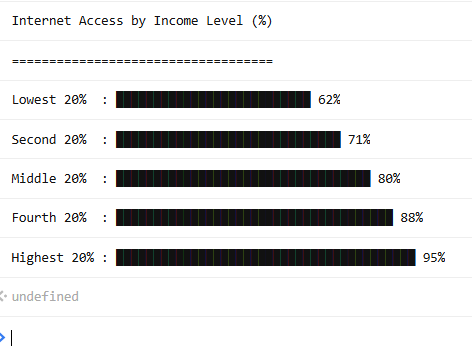
Code Snippet 1.1
The output shows that the lowest income has less internet than the higher income which has more internet. This makes sense because the rich are able to buy more expensive computers and more of those computers unlike the poor.
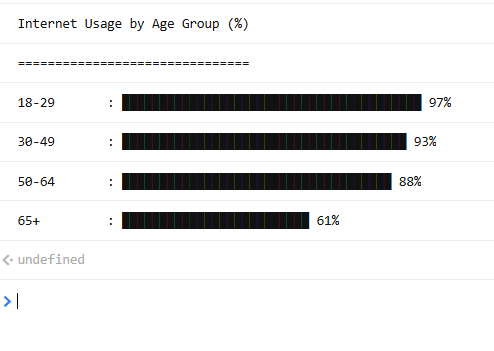
Code Snippet 1.2
The output shows that the younger age groups tend to use more internet than the older age groups. This is most likely due to the fact that old people simply do not know how to use internet and are not used to it because as a kid they probably didn’t have it as much as the young people.
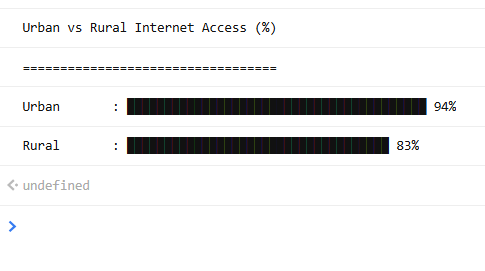
Code Snippet 1.3
The output shows the internet access for those living in rural vs urban places. There is more internet access in urban rather than rural areas. This makes sense, but also causes digital divide because there are usually more people in Urban areas so they would probably prioritize the majority rather than the minority
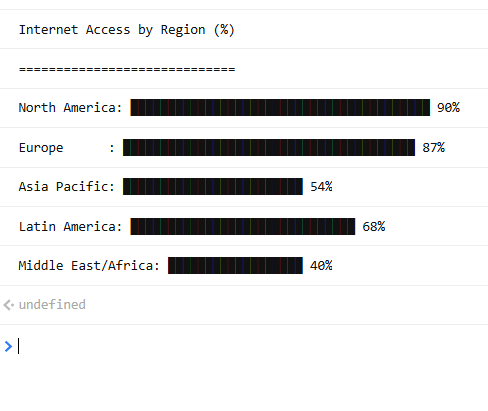
Code Snippet 1.4
I can see that areas like North America and Europe have a lot of internet access by region when compared to places like Africa or the Middle East. I believe this is something economic wise. Higher income places like America probably have access to more technology of a higher quality and higher quality internet when compared to places like Africa which aren’t as rich.
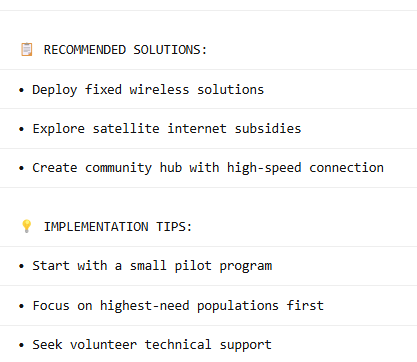
Code Snippet 2.1 (Rural Area + Access Problem + Limited Budget)
This solution focuses on bringing internet access to rural areas through wireless and satellite options while establishing shared community hubs. This makes sense because the budget here is usually limited and this plan suggests starting small and leveraging volunteers.
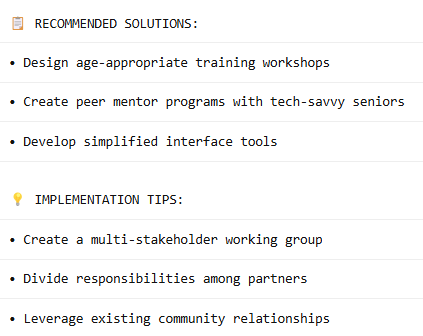
Code Snippet 2.2 (Senior Citizens + Digital Literacy + Community Partners)
This approach helps seniors improve digital skills through tailored workshops and peer mentoring. Since community partners are available, collaboration can help to share resources and expand the program more effectively.
Essay Question (Compare and contrast the digital divide challenges faced in urban versus rural communities. What solutions might be effective in each context?)
Urban vs rural communities face different digital divide challenges due to their differences in population, income, and more. In urban areas, the biggest issue is affordability as low-income families that reside there that are not able to pay for the high-speed internet that others can afford. This is surprising though because these areas tend to have a stronger digital infrastructure. On the other hand, rural areas struggle with access to technology because of its lower population. There are less providers that would invest into digital infrastructure due to this reason. Potential solutions for urban communities include programs such as the “Affordable Connectivity Program” (https://www.fcc.gov/acp) to help low-income families afford good quality internet. For rural communities, certain government initiatives that expand networks and provide satelite-based internet services, such as SpaceX’s Starlink (https://www.starlink.com/us) could be a solution.
Essay Question (Analyze how the COVID-19 pandemic exposed and potentially exacerbated existing digital divides. Include at least three specific examples.)
The COVID-19 pandemic worsened digital divide in regards to education, healthcare, and employment. To begin, students (like us) for forced into using online school. This by itself leads to a digital divide as school and education is now dependent on internet quality, device quality, access to devices/internet, which could lead to significant learning and education losses to low-income or rural areas. In fact, many school districts distributed hotspots to make sure that all students would be having equal education and learning (https://edsource.org/2021/california-schools-build-community-wireless-networks-to-bridge-digital-divide/645919). In healthcare, telemedicine became vital as even a simple in-person visit to the hospital became deadly and increased the risk of COVID-19. Since some individuals did not have access to internet or devices, this automatically left this option off the table for them creating a digital divide. The simple fact that some elderly patients and people in general didn’t have medical care just because of internet access creates this digital divide. Finally, many peoplen were laid off and the job deparment became scarce. Jobs transitioned into online-jobs and workers without a stable internet connection or digital skills were unable to transition and do this at home. This worsened the economic inequality and caused a digital divide.
Extra Credit Opportunity
USA:
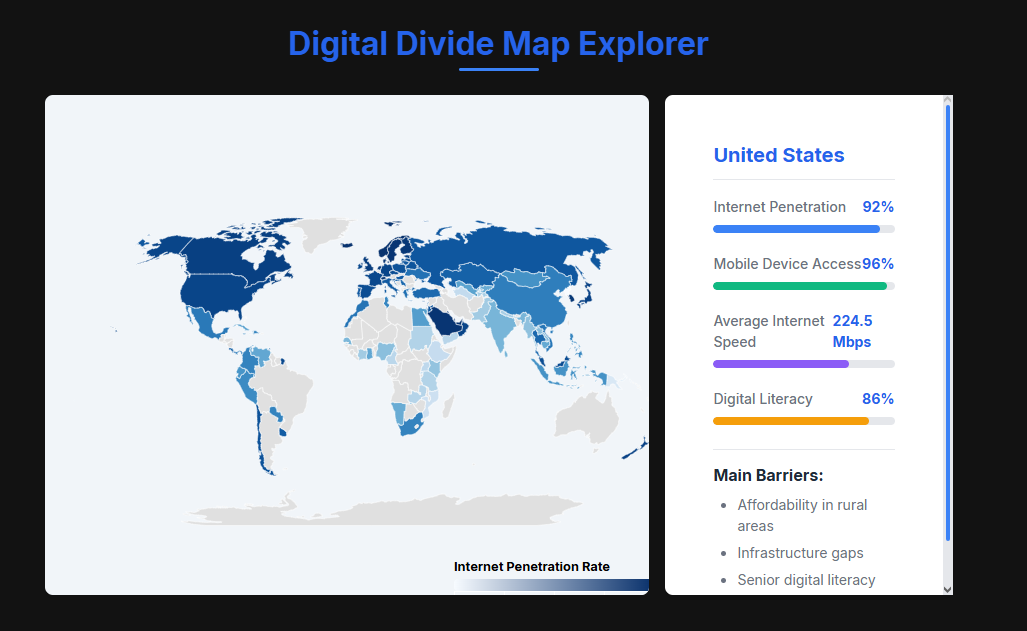
Namibia:
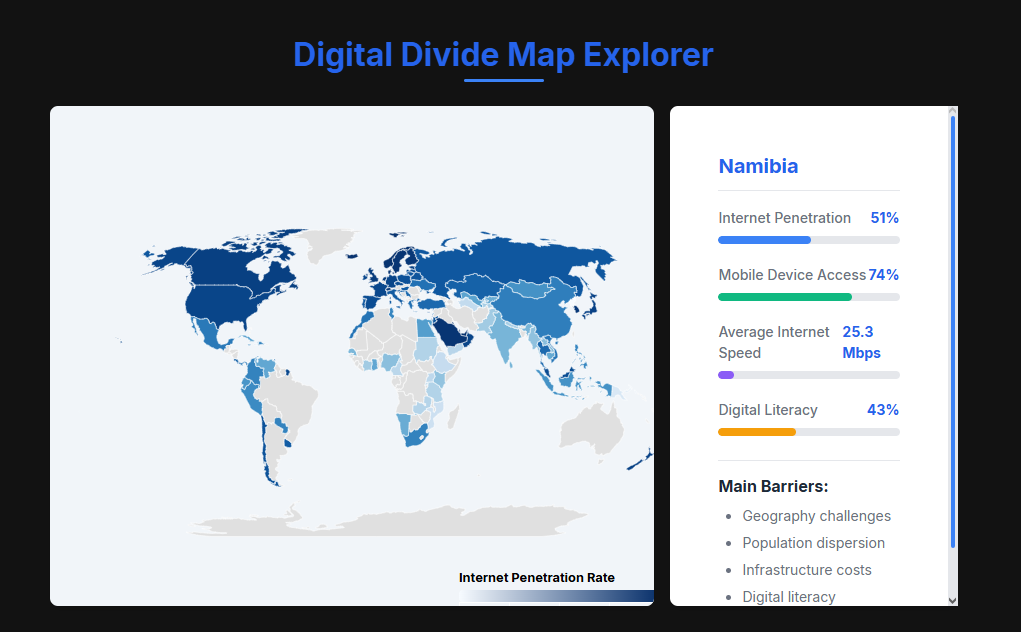
The digital divide between the United States and Namibia mostly comes from affordability, access, and literacy. As shown in the photo, in the US most of the population has access to really high-speed internet, most of everyone has phones, and most of everyone has digital literacy. On the other hand, the average speed of internet in Namibia is terrible compared to the US, and the internet penetration is extremely limited. Even to those people that have devices, the digital literacy is very low. I think that this is due to the wealth differences between the two and solutions include government initiatives like “Afforadable Connectivity Program” (ACP link was sent before) that aims to allow every country no matter how poor or rich to have high-speed working internet connection. Additonally, the Namibian government is focusing on expanding mobile coverage, reducing costs, and improving digital literacy, but again is slow compared to the US due to economic limits. These two solutions are exactly what this place needs to improve these statistics, but all they need is time.